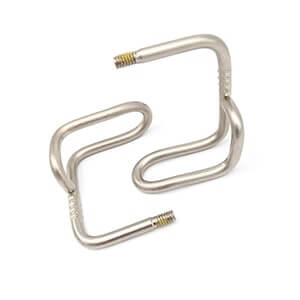Get unique, complex parts easily. No matter your requirements, Chaoyi Spring creates hard-to-produce coil springs and wire forms.
Let us help you create the custom wire form you need, from S-hooks and J-hooks to utility hooks and more.
We work closely with customers across a wide range of industries, helping them design and manufacture made-to-order parts.
Why choose Chaoyi Spring? We prioritize customer-focused collaboration, modern equipment and the latest technology to make your parts per print.
Find the information and guidance you need, from measuring a spring to learning about materials, placing an order and much more.
Garage doors are a vital part of any home, providing security, convenience, and protection from the elements. However, these heavy-duty doors rely on a system of springs, cables, and rollers


Garage doors are a vital part of any home, providing security, convenience, and protection from the elements. However, these heavy-duty doors rely on a system of springs, cables, and rollers to operate smoothly. One of the most critical components is the tension spring, which balances the weight of the door, making it easier to open and close. Over time, these springs can wear out, become weak, or even break, leaving your garage door stuck or dangerously unbalanced. This article will guide you through the process of replacing tension springs, ensuring a safe and functional garage door for years to come.

Before attempting any repairs on your garage door, it's crucial to understand the inherent dangers involved. Tension springs are under immense pressure, and a sudden release could cause serious injury or even death. They are not meant to be handled lightly, and it's best to leave repairs to professionals unless you have the proper experience and safety equipment. If you decide to proceed with the replacement, make sure you have a helper, a sturdy ladder, and the appropriate safety gear, including heavy-duty gloves, safety glasses, and a sturdy ladder.
Before diving into the replacement process, it's essential to determine whether the issue truly lies with the tension springs. While a broken or weakened spring is the most common culprit behind a dysfunctional garage door, other factors, such as damaged cables, worn-out rollers, or a malfunctioning opener, could also be at play. Inspect the door carefully for any visible signs of damage, such as frayed or broken cables, bent or cracked rollers, or any unusual noises during operation.
Once you've confirmed that the tension springs need replacing, gather the following materials and tools:
Now that you have all the necessary tools and materials, let's embark on the process of replacing the tension springs. This is a delicate procedure that requires meticulous attention to detail and unwavering safety consciousness:
After successfully replacing the tension springs, it's always wise to perform a final inspection to ensure everything is functioning correctly and safely. Check the cables for proper tension and alignment, and ensure the rollers are moving freely. If you hear any unusual noises, or notice any signs of binding or resistance, immediately stop using the door and consult with a professional.
Replacing tension springs on a garage door is a challenging task that requires a degree of mechanical aptitude and an understanding of safety precautions. If you're not comfortable with the process, it's always best to hire a qualified professional to handle the job. However, with careful planning, the right tools, and a focus on safety, you can successfully replace your tension springs and restore your garage door to its proper functionality.
Remember, safety should always be your top priority. If you're not confident in your abilities or comfortable working with high-tension springs, don't hesitate to call a professional. A properly functioning garage door provides peace of mind and ensures the safety of your home and belongings. By understanding the process and taking necessary precautions, you can tackle this project with confidence and enjoy the benefits of a smooth and reliable garage door for years to come.
Browse some of the custom wire forms and springs that we manufacture. Don’t see what you need? We specialize in made-to-order products that meet your application requirements.
Visit Our GalleryNeed a custom wire form or coil spring? We make it work. Fill out the contact form and a representative will respond within 1 business day. If you have a PDF or CAD file, you can submit to request a quote.